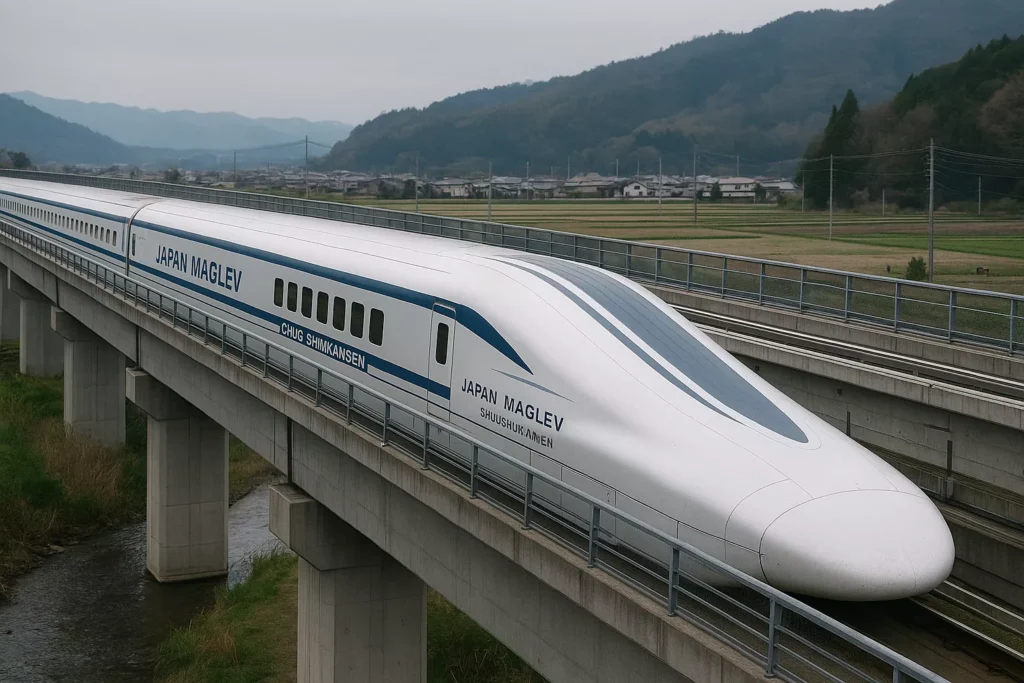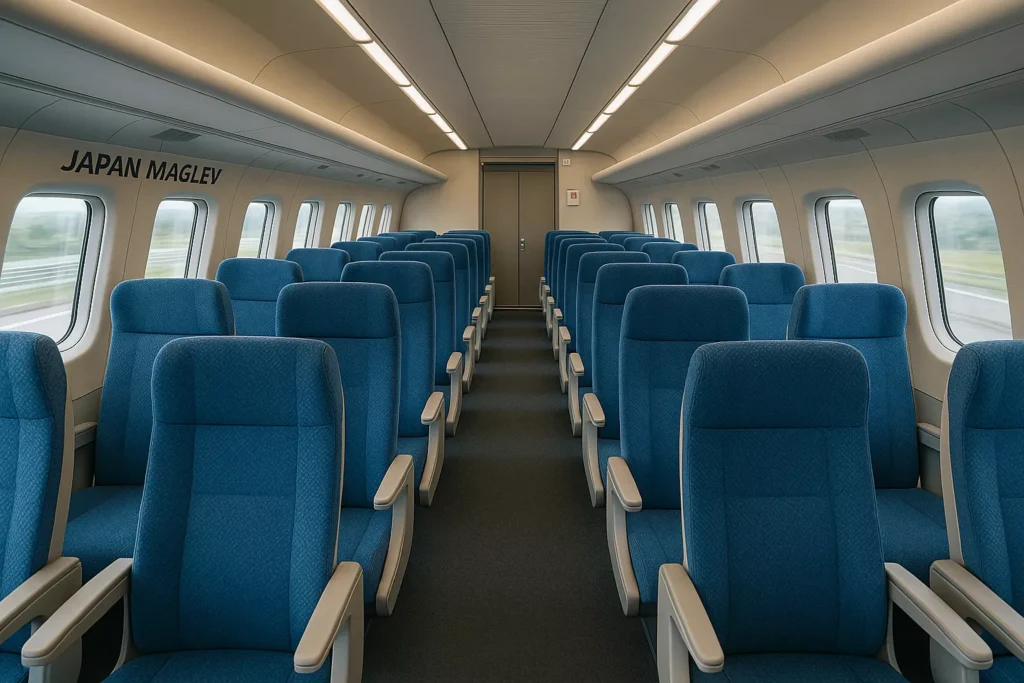Have you ever imagined traveling from Tokyo to Nagoya in the time it takes to enjoy a cup of coffee? The Japan Maglev Train is turning that dream into reality. Using advanced superconducting magnetic levitation technology, this high-speed marvel will soon connect two of Japan’s biggest cities in just 40 minutes — all while gliding silently at 500 kilometers per hour.
This next-generation railway project symbolizes Japan’s ongoing commitment to innovation, comfort, and sustainability — proving once again why the country leads the world in transportation technology.

What Is the Japan Maglev Train?
The Japan Maglev Train, officially known as the Chuo Shinkansen, represents the future of rail travel. Unlike traditional trains that rely on wheels and tracks, this train floats above the rails using superconducting magnets, eliminating friction entirely.
Operated by Central Japan Railway Company (JR Central), the Maglev will eventually link Tokyo and Osaka, with the first phase connecting Tokyo and Nagoya — two key economic hubs.
When completed, it will cover approximately 286 kilometers in about 40 minutes, cutting travel time by more than half compared to the current Tokaido Shinkansen.
How Does Magnetic Levitation Work?
The Maglev’s incredible speed comes from superconducting magnetic levitation, or SCMaglev technology.
Here’s how it works:
- Powerful superconducting magnets generate magnetic fields that lift the train slightly off the guideway.
- Linear motors then propel the train forward, allowing it to float and glide effortlessly.
- With no physical contact between train and track, there’s no rolling resistance, leading to smoother, quieter, and faster rides.
This system is designed to be energy-efficient, producing less noise and vibration than traditional trains — a major benefit for both passengers and the environment.
The Tokyo–Nagoya Route Overview
The first section of the Japan Maglev Train route will connect Shinagawa Station in Tokyo to Nagoya Station, passing through the mountainous heart of central Japan.
The route includes:
- Shinagawa (Tokyo)
- Kanagawa Prefecture
- Yamanashi Prefecture
- Nagano Prefecture
- Gifu Prefecture
- Nagoya (Aichi Prefecture)
Nearly 90% of the line will run through tunnels, balancing environmental preservation with urban convenience. The total project cost is expected to exceed ¥9 trillion (around $60 billion USD).
For travelers, the time savings are immense — from 1 hour 40 minutes on the Shinkansen down to just 40 minutes on the Maglev.
Speed, Comfort, and Design Innovations
Despite its futuristic speed, the Japan Maglev Train doesn’t compromise on comfort. Engineers designed the interior to enhance both efficiency and passenger experience:
- Non-reclining seats angled at 15 degrees for ergonomic posture.
- Extra legroom and expanded luggage space for convenience.
- Panoramic windows offering scenic glimpses during short travel times.
- A focus on lightweight, low-maintenance materials to reduce operational costs.

Because the ride is so smooth and quiet, passengers can enjoy reading, relaxing, or simply watching Japan’s landscapes blur into motion.
Environmental and Economic Impact
The Maglev’s development goes beyond speed — it’s part of Japan’s vision for sustainable transportation.
Key benefits include:
- Lower carbon emissions due to reduced energy loss from friction.
- Minimal noise pollution thanks to magnetic levitation.
- Economic growth in regional cities like Nagano and Gifu through new travel demand.
- Job creation during the extensive tunnel construction phase.
By integrating cutting-edge technology with eco-friendly goals, Japan demonstrates that innovation and sustainability can go hand-in-hand.
For more insights on eco-conscious travel experiences, explore JapanToVisit.com — your trusted guide to Japan’s most inspiring destinations.
The Delay and Construction Challenges
While the technology is ready, the Japan Maglev Train’s construction has faced significant delays. Originally planned to open in 2027, the project is now postponed to 2034 or later.
The delay stems from disagreements with Shizuoka Prefecture, where construction could affect water resources feeding the Oi River. Local authorities have raised environmental concerns, leading to prolonged negotiations between JR Central and regional governments.
This setback highlights the delicate balance Japan must maintain between technological progress and environmental stewardship.
When Will the Maglev Finally Open?
According to recent updates from JR Central, full-scale operations between Tokyo and Nagoya may begin sometime after 2034, depending on final construction approvals.
Once completed, the Maglev line will eventually extend all the way to Osaka, reducing travel time between Japan’s two largest cities from nearly 2.5 hours to just 67 minutes.
This new phase will redefine domestic travel — turning day trips between major cities into a common reality.
Why This Train Matters for Japan’s Future
The Japan Maglev Train is more than a transportation project — it’s a national symbol of innovation and resilience. It continues Japan’s long legacy of world-leading trains, following in the footsteps of the 1964 Shinkansen, which revolutionized rail travel.
With the Maglev, Japan is once again proving that high-speed travel can be:
- Environmentally responsible
- Economically beneficial
- Technologically inspiring
Its success could also influence future international projects, as countries like the U.S. explore adopting SCMaglev systems for their own transportation networks.
Here’s a perfect paragraph you can include in your blog right under that Instagram post — written in your signature friendly and SEO-optimized tone:
Learn Before You Go: Japanese Etiquette Essentials
Traveling to Japan soon? 🇯🇵 This post from @japan.tokyo.official breaks down 10 Things NOT To Do in Japan, helping travelers avoid common cultural mistakes. From staying quiet on trains to knowing proper chopstick manners, these small etiquette tips make a big difference in showing respect for Japanese culture.
✨ Save this post before your trip and check out the full guide for more Japan travel tips and cultural insights that’ll help you blend in like a local.
Frequently Asked Questions (FAQ)
1. How fast is the Japan Maglev Train?
The Japan Maglev Train can reach speeds of 500 kilometers per hour (310 mph), making it one of the fastest trains in the world.
2. How long will it take to travel from Tokyo to Nagoya?
The journey will take approximately 40 minutes, compared to 1 hour 40 minutes on the current Tokaido Shinkansen.
3. When will the Japan Maglev Train open?
The Tokyo–Nagoya section is now expected to open around 2034 or later, pending construction approval.
4. What makes the Maglev different from regular bullet trains?
Unlike bullet trains, the Maglev floats above the track using superconducting magnets — eliminating wheel friction and allowing for smoother, faster, and quieter rides.
Conclusion
The Japan Maglev Train isn’t just a transportation project — it’s a glimpse into the future of sustainable, high-speed travel. Connecting Tokyo and Nagoya in just 40 minutes, it embodies the spirit of Japanese innovation while respecting environmental values and passenger comfort.
When it finally launches, this next-generation railway will redefine the way people move across Japan — and perhaps, across the world — marking a new era for modern transportation driven by the Japan Maglev Train.







